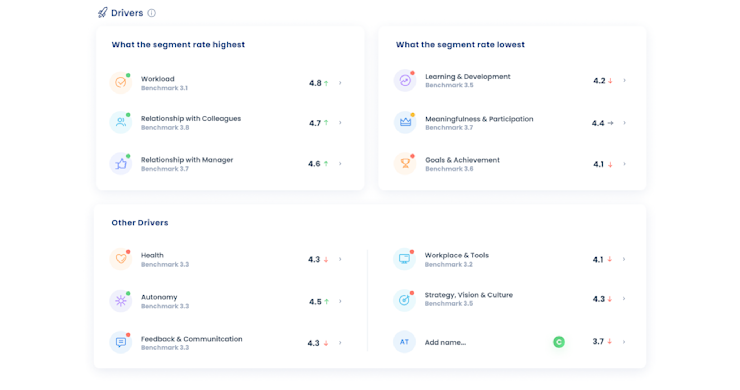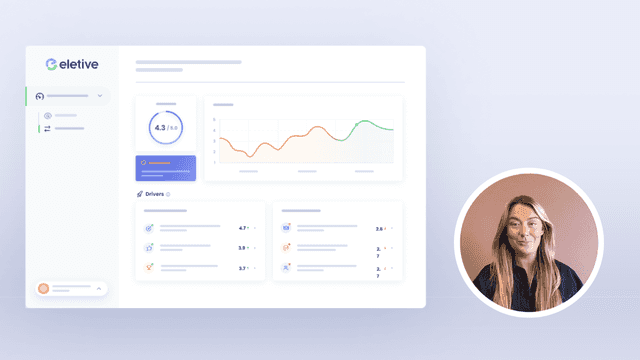The importance of employee engagement is something most of us understand intuitively. It makes sense that people who are engaged in their work will enjoy it more and perform better. But what are the drivers of employee engagement?
Research shows us that a highly engaged team can increase productivity by 17% and reduce absenteeism by as much as 41%. This means that increasing employee engagement often is one of the quickest and most efficient ways for organizations to improve employee performance as well as overall results. An engaged workforce also means reduced employee attrition, less sick leave, and a stronger employer brand.
Disengaged employees will rarely deliver a high performance. Highly engaged employees, on the other hand, can impact business outcomes dramatically through discretionary effort and going that extra mile to create a better result.
What are the drivers of employee engagement?
You know what they say, what gets measured gets managed. So in order to improve employee engagement, organisations need the means for measuring it. And not only as a whole, because employee engagement is a multifaceted and complex concept. But rather to measure the different drivers of employee engagement, by letting employees rate them. By doing so, it becomes possible to focus on the areas where there is a need for improvement, and gradually build a better employee experience.

So, what are the different drivers of employee engagement? In the Eletive platform, we focus on 11 different aspects of the employee experience.
Feedback and communication
Autonomy
Meaningfulness and participation
Workload
Health
Workplace and tools
Learning and development
Goals and goal achievement
Strategy, vision, and culture
Relationship with manager
Relationships with colleagues
Keep reading to learn more about the drivers behind employee engagement, and why these are important areas to cover when collecting feedback from employees.
Feedback and Communication
Effective communication and constructive feedback are among the top drivers of employee engagement. Receiving adequate and constructive feedback helps employees understand where they’re doing well, and in what areas they can improve. Feedback impacts engagement levels and can also strengthen relationships between managers and employees. Employees that receive constructive feedback on areas such as performance, work progress, resources, obstacles, and solutions are usually both more engaged and more productive.
Autonomy
A sense of autonomy is crucial to maintain high employee engagement. This includes each employee’s perception of their possibility to impact and influence various aspects of their work and work environment. This can include the ability to influence things like work pace, tasks, and decisions that affect one’s work.
The opposite of autonomy is micromanagement, where employees are not trusted to make any decisions on their own. Most people would agree that being micromanaged is suffocating and very detrimental to employee engagement. When employees get to choose how to manage their time and how to use their expertise, the chances of them becoming more invested in the company and its mission increase.
Meaningfulness and participation
Finding meaning in work is an essential aspect of employee engagement. When employees find their work meaningful, working is something that feels valuable and it’s something they want to immerse themselves in.
The feeling of meaningfulness is closely connected to a sense of purpose, and depending on the individual, the meaning can be derived in different ways. For some people, a shared purpose for a greater good will create a sense of meaningfulness, whereas others derive their sense of purpose from factors like appreciation, compensation, status, or influence. What makes work meaningful differs very much between individuals, but whatever it is in each case, it’s closely connected to employee engagement.
Participation is also closely connected to meaningfulness and alludes to the sense of being respected and treated well and fairly by colleagues and managers. A feeling that one’s opinions, ideas, and contributions matter are also important in the context of this driver.
Workload
Workload represents an employee's perceived levels of demands and control at work. The demands can come from different directions and be of various kinds. Work demands can for example come in the form of direct orders from a manager or colleagues. But demands also occur as expectations from customers or other stakeholders. The levels of control perceived by the employees will often affect the outcome.
A good balance between demands and control leads to a healthy work situation and a positive employee experience. Too many or too high demands, combined with too little control over the situation, will instead result in unhealthy stress. When the workload becomes unhealthy, it has a negative impact on engagement and performance.
Health
Health is closely connected to employee engagement. Health problems affect employee engagement and performance, and of course also employee well-being, negatively. Health is a multifaceted concept, and three major components of maintaining good physical and mental health, are eating habits, sleeping habits, and exercise habits. In addition to ensuring healthy habits, it’s also important to be wary of symptoms of unhealthy stress. Detecting early warning signs of unhealthy stress can help employees that might be at risk of developing stress-related illnesses prevent that.
Workplace and Tools
The physical aspects of the workplace are an important factor in employee engagement. Having the right tools and functional work environment will significantly impact an employee's ability to perform their tasks, but also their perception of the work environment and how they feel about their work. Therefore it’s important to include this more practical aspect of the employee experience when trying to understand the full picture. It’s important to note that subjective perceptions are equally important as the factual circumstances since it’s peoples’ perception of whether they have adequate resources, such as tools and methods, that will impact their level of engagement the most.
Learning and Development
Learning and development are key drivers of employee engagement and employee satisfaction. And of course, allowing employees to develop their skills and enhance their knowledge is a win-win. Not only will you build a more capable and confident workforce. At the same time, you show your employees that you value them and are willing to invest in their development. Having the feeling that there are opportunities for growth and development at work contributes to building a motivated, happy and engaged workforce.
Goals and Goal Achievement
Setting clear goals and achieving them is fundamental to employee engagement. It’s essential that goals are clear and understandable, realistic, and also challenging enough to be inspiring. But setting goals and reaching them is not done in a vacuum, and as always, the subjective experience of each employee will matter. Different individuals have different needs, and the only way to know how an employee feels is to ask.
Strategy, Vision, and Culture
Understanding the strategy and vision of an organisation, and feeling supported by the work culture, contribute to a higher level of employee engagement. If employees have understood the core purpose of an organisation, and how their contribution impacts the overall objective, chances are higher that they will feel motivated and engaged. If the employee identifies with the purpose and culture of the organisation, it will create an even higher level of engagement and commitment.
Relationship with Manager
Managers play an essential role in employee engagement. The manager-employee relationship is critical and can make or break an organisation. A good relationship with the manager includes good leadership, good communication, support, trust, and fairness. An important aspect is also the managers’ ability to see the individual differences and to adapt their leadership to different situations and employees.
Relationships with Colleagues
One of the most important factors in employee well-being, employee engagement, and employee retention is the relationships with colleagues. When there is a strong team spirit and healthy, supportive relationships between team members, the chances of high employee engagement increase. This involves things like communication, support, trust, and conflict management. It also encompasses how employees see each other when it comes to responsibility, quality of work, and overall performance.
Employee engagement surveys to measure the drivers of engagement
Human resources play an important part in the puzzle when it comes to creating a high-performing company culture and a high level of employee engagement. To achieve this, HR and people teams need agile tools for collecting employee feedback, and for gauging the level of engagement and overall job satisfaction. An employee engagement strategy requires the tools for collecting, analyzing, and taking action on the results.
Related reading: How intelligent employee surveys can improve your people decisions
Eletive is a modern People Success Platform, gathering all the tools needed for building a workplace where people thrive and perform at their best. Get in touch with our team of experts to learn more!

























